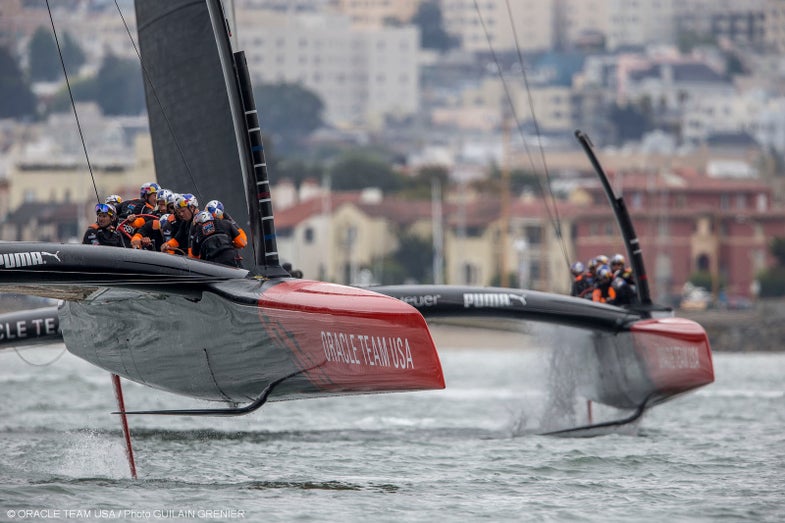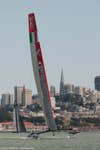Click here to enter the gallery
Now underway in the San Francisco Bay is the America’s Cup Finals, the last stage of this year’s America’s Cup international sailing yacht competition. After four of nine races, the current trophy-holding team, America’s Oracle Team USA, has won one race while the challenging Emirates Team from New Zealand has won three.
Since the first America’s Cup race in 1851, advances in technology have made the yachts significantly faster and stronger. Here’s a gallery of the extreme tech behind some of the world’s fastest boats.
34th America’s Cup, Louis Vuitton Cup Semi-Finals: Luna Rossa Vs Artemis Racing
The AC72 catamaran is the current model designed for and sailing in the 2013 America’s Cup Finals. This 72-foot-long boat has a solid wing instead of a billowing sail. Having a fixed wing in place of a traditional mast and sail provides more speed, but is also more dangerous. Larry Ellison, the last winner of the Cup, won with a wing-sail powered trimaran. By virtue of winning the Cup, and becoming the defender, he got to rewrite the race’s rules. So for the 34th America’s Cup he required competitors to race using the lightweight AC72s. Ellison’s aim was to convert sailing into an extreme sport.
Artemis’s Crew in San Francsico, wearing safety gear
Not that long ago, any skilled sailor could have piloted an America’s Cup boat. Now racing the high-tech catamarans requires sailors that have more in common with highly skilled technicians and extreme athletes than your typical yachtsman. Their jobs are more physically demanding than ever before. They are also much more hazardous. An experienced Olympic sailor was trapped underwater and perished in early May when the Swedish boat Artemis capsized during training. Every one of the crew of eleven must now wear crash helmets and body armor, in addition to personal flotation devices. They also carry bottled air in case they are thrown from the boat, personal locator beacons, and knives to cut away rigging if trapped. They also have self-lowering devices to keep them from getting stranded several stories above the water if the boat tips over.
Louis Vuitton Cup Final, Day 4
The boats in the 34th America’s Cup are insanely fast. When the AC72 reaches 43 knots, or about 49 miles an hour, it sails its 72-foot length in one second. The sloops in the 2007 America’s Cup had an average top speed of 12 knots, or about 14 miles per hour. At that speed it took four seconds to sail their 80-foot length. Put another way, the sailboats sailing in the race area just next to the Golden Gate Bridge, will be exceeding the speed limit for cars on the bridge.
The Wing Of An AC72
The solid carbon-fiber wing powering the AC72 is 13 stories tall and weighs 2,965 pounds—as much as a small car. It has a surface area of 260 meters squared, which is about the size of the wing of a Boeing 747-400.
Hydrofoiling
The AC72 can lift itself out of the water and hydrofoil, both downwind and upwind. Foiling plays a big part in getting the boat up to such high speeds. When the is lifted out of the water on the daggerboards, less than 22 square feet of the boat is in contact with the water. That’s about the same surface area as an XL twin sized bed.
Turning the AC72
Turning at top speed is extremely difficult. There is no way to take down a wingsail, so turning requires every person on the team. Sails have to be depowered (flaps and cables change the shape of the wing). The daggerboards have to be adjusted, and the helmsman carves the tiller in perfect synchrony and as fast as possible. If anything goes wrong the boat could capsize.
Resisting The Wind
The head of the jib, the top corner of the soft forward sail, is designed to be able to withstand 18,000 pounds of force from wind.
Working On The AC72
According to Team Oracle USA, it takes 77,000 man-hours to build an AC72. It takes just seconds to wreck one.








